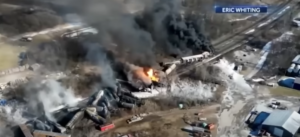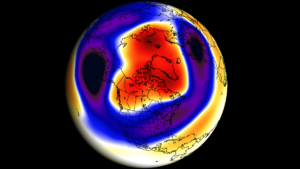We talk mental health in the climate crisis with Dr. Susan Clayton, author of the Climate Anxiety Index. Then we go tiny: pollinators are disappearing at an alarming rate. Now we know the cost – in dollars and lives lost, with research scientist Matthew Smith from the Harvard Chan School of Public Health in Boston.
Listen to or download this Radio Ecoshock show in CD Quality (57 MB) or Lo-Fi(14 MB)
WHITE NOISE AND THE OHIO TANKER FIRE
In an impossible twist, some of the people fleeing the giant rail tanker fire in Ohio appeared two years before in a movie. The movie shows people fleeing a giant rail tanker fire. Art. Precedes. Reality.

“I feel sad for us in the queer part we play in our own disasters, but out of some persistent sense of large-scale ruin, we keep inventing hope.”
That quote is from the recently released Netflix film “White Noise”. It is a disaster comedy, directed by Noah Baumbach. The film was adapted from the 1985 novel by dark American author Don DeLillo. You should see White Noise. This beautiful film contains an homage to industrially packaged life and disaster worship in American culture.
Reality on the ground in Ohio is a hellscape of cancer-causing chemicals. The deadly chemicals leaked out, heading toward the Ohio river and beyond. Locally, fish were already dead. Incredibly, authorities on the scene ordered the whole chemical soaked mess set on fire. They would “burn off” the toxic chemicals.
Burning the chemical tank cars spread the toxic load over the Eastern United States, and some feared as far as Canada. Canadian health authorities predictably said that was “highly unlikely.” Nobody wants to admit this is happening. It took days for national media to report the accident. The truth is still best found piece-meal in local TV stations with the local angle, or alternative press like Common Dreams.
Will the Ohio Chemical Train Cloud become America’s Bhopal? It will take years to know. Scientific studies take time, and more time to publish. Some health effects, including damaged lungs, take years to show up. Cancers can take decades, but as the song goes in the movie White Noise: “The cloud is coming for us all.” A long time from now, it is possible people will pass away a few years too soon, poisoned by chemicals for our plastic, one time in Ohio.
This Ohio train disaster should go into Paul Virlio’s imagined “Museum of the Accident”. Both Virolio, and Don DeLillo tell us accidents are not outside the new normal, but a foundational part of it. Virilio suggested accidents are themselves an important subject of study. He proposed “Accidentology” and wanted to build a Museum of the Accident in Paris. That did not happen, yet.
Be sure to listen to my program “Paul Virilio and the planetary accident”, posted on December 15, 2021
ALSO take a look into this article (not from corporate press): The Ohio Derailment Catastrophe Is a Case Study in Disaster Capitalism
AND MAYBE THIS YOUTUBE VIDEO from Upper Echelon
===========================
DR. SUSAN CLAYTON –
HOW IS YOUR CLIMATE ANXIETY?
If you are not worried about climate change, you don’t know, don’t want to know, or try hard not to think about it. But experts find millions of people are suffering psychologically. They have climate anxiety, or depression, and other symptoms that damage lives.
In a worried world, Dr. Susan Clayton is busy. She is an acknowledged expert in the field. Clayton helped develop a scale to measure climate anxiety. She publishes assessments for the American Psychological Association. Susan helped cover this growing problem in the latest report by the Intergovernmental Panel on Climate Change. In Ohio, at the College of Wooster, Clayton is a social and environmental psychologist. She is also a visiting fellow at the Institute for Advanced Studies in Paris
Listen to or download this 27 minute interview with Susan Clayton in CD Quality or Lo-Fi
The Center for Disease Control just issued a serious warning about deteriorating mental health in American teens. The CDC said: “In 2021, more than 4 in 10 [(42%)] students felt persistently sad or hopeless.” One child in ten attempted suicide. This is terrible! The pandemic did not help. But is climate anxiety part of it, and how do you know?
My studio is in British Columbia, Canada. My wife and I lived through the record-smashing heat dome in 2021. That was after the wild fires burned half the area around us in years before. We used to love summer, but now my wife dreads it. Susan Clayton and team did a study on the 2021 heat dome in B.C. and how people felt about it. This was fortuitous, because a full survey of residents was done just before the fires. With a follow-up, these researcher were able to track the impacts, the changes in people’s feeling and attitudes. The paper is: Bratu, A., et al. (2022). The 2021 Western North America heat dome increased climate change anxiety among British Columbians: Results from a natural experiment. Journal of Climate Change and Health.
In B.C. after the fires, Clayton et al found: “Most participants indicated that they were much (40.1%) or somewhat (18.4%) more worried about climate change due to the heat dome. “
With her Wooster colleague Brian Karazsia, you developed a climate anxiety scale. It has been tested and validated in several countries, including Poland and Germany. “To this end, Clayton and Karazsia (2020) recently proposed a climate change anxiety scale (CCAS). The CCAS is designed to capture the extent to which people experience cognitive-emotional and functional impairment as a result of thinking about climate change.”
That Anxiety Scale paper is “Development and validation of a measure of climate change anxiety”
April 2020 Journal of Environmental Psychology 69:101434
TO FIND OUT MORE ABOUT CLIMATE AND MENTAL HEALTH…
A whole lot of major institutions are waking up to the massive problem of mental health during the destruction of nature. Susan Clayton is with the American Psychological Association. The American Psychiatric Association has pamplets online about this. The World Health Organization has named mental health as a priority in climate risk and response. Susan Clayton helped write the first strong language about this threat in the latest report from the Intergovernmental Panel on Climate Change.
One thing I ask Susan: Do you think millions of people could become anxious or depressed to the point they cannot react to obvious climate damage? Is climate change disabling the ability to respond to climate change?
Clayton and Manning published an influential book on the subject in 2018: “Psychology and climate change: Human perceptions, impacts, and responses.” Susan also published a review “Climate Change And Mental Health” In Jan. 2021 in Current Environmental Health Reports [$paywall]
========================
MATTHEW SMITH: POLLINATORS IN DEEP TROUBLE
Do you like vegetables, fruits, and nuts? They are the healthy foods. On this planet, they all depend on other animals, from bugs to bats, to fertilize flowers that become our food. As you know pollinators are in trouble. Humans change the landscape, apply pesticides, and heat up the climate. Are we headed into a pollinator crisis?

Dr. Matthew R. Smith is a Research Scientist at the Harvard Chan School of Public Health in Boston. In earlier work, he asked: “What happens if we lose the pollinators?” Now Matthew leads a team adding up the consequences for food and human health, as pollinators decline. The cost is high already, in money and lives lost.
Listen to or download this 26 minute interview with Matthew Smith in CD Quality or Lo-Fi
The opening of this new study might confuse our listeners. When experts talk about “pollinator animals”, we picture wildlife brushing up against plants or something. But scientifically, insects are animals. So pollinators includes the usual bees, moths, and even flies but also creatures like bats and birds who aid in pollination.
WHAT HAPPENS IF THE POLLINATORS DIE?
A study published October 2022 in Nature finds 65% of all insect populations they examined could go extinct this century. Famous scientist Albert Einstein said “If the bee disappeared off the face of the Earth, man would only have four years left to live.” Matthew did an earlier study asking “What happens if all the pollinators die?” That was in 2015, in the top medical journal Lancet.
No, humans would not die off. Many of our grains are pollinated by other forces, like wind. A few plants like peas are self-pollinating. Millions might starve without crops grown by pollinating “animals”, and the general health of populations would be poorer, but humans would not go extinct! Unless other parts of Nature fall apart without the pollinators and later we start to lose out…
With 100% removal of pollinators, they found that supplies of fruit, vegetables, nuts, and seeds could fall by 16%–23%, leading to 1.4 million additional annual deaths globally due to the ensuing dietary and nutritional changes.
COUNTING UP LOSES IN MONEY AND HEALTHY YEARS LOST…
The Open Access paper for this interview is: “Pollinator Deficits, Food Consumption, and Consequences for Human Health: A Modeling Study”.
RESULTS:
“Globally, we calculated that 3%–5% of fruit, vegetable, and nut production is lost due to inadequate pollination, leading to an estimated 427,000 (95% uncertainty interval: 86,000, 691,000) excess deaths annually from lost healthy food consumption and associated diseases.
Modeled impacts were unevenly distributed: Lost food production was concentrated in lower-income countries, whereas impacts on food consumption and mortality attributable to insufficient pollination were greater in middle- and high-income countries with higher rates of noncommunicable disease.
Furthermore, in our three case-study countries, we calculated the economic value of crop production to be 12%–31% lower than if pollinators were abundant (due to crop production losses of 3%–19%), mainly due to lost fruit and vegetable production.”
So around half a million people a year die prematurely simply because they cannot get enough healthy fruits, nuts and vegetables that depend on insect pollination. It could be less or more. It works out to roughly 5% of fruit, 3% of vegetables and 5% of nuts are lost world-wide because of pollinator decline. That also represents a lot of lost labor, wasted water, and profits from farms that could have done better. Harmful pesticides and herbicides may also have been used, even though the crop got to the flowering stage, but then stalled and produced less food due to lack of pollinators.
========================
UNSTABLE WEATHER IS THE NEW “NORMAL”
American weather has been one long accident this winter. In the United States, the January 2023 temperature was 5.1 degrees Fahrenheit warmer than average, the sixth warmest January on record. That is according to the U.S. Government agency NOAA. Most states in New England set an absolute record for January heat this year, with second warmest for New York and Pennsylvania.
On Thursday Feb 23, thermometers went over 70 degrees in Islip New York and Bedford Massachusetts. That’s over 21 degrees C. – crazy summer weather in winter. Strange isn’t it? Of course weather whip-lash may still set in. High above us, even higher than the Chinese spy balloon, a relatively rare Sudden Stratospheric Warming Event has already begun. This could distort the Polar Vortex below, tossing frigid weather back across the continent for a few days. Maybe that will hit Eastern Europe as well. The rest of this winter is, as they say, “still up in the air”.

Not reported in North America or Europe: Argentina has been roasting in climate-changed heat. It is summer there. After the warmest November to January since 1961, 27 cities broke absolute temperature records in mid-February, the eighth consecutive in a row. It was 38.1 C, just over 100 degrees F, in the capital Buenos Aires, the highest in four decades. Night time temperatures only went to 28.5 C or 83 Fahrenheit. Those are deadly nights.
But Argentina and surrounding countries in Central South America have been in a terrible drought since 2019. According to new science, “with the last four months of 2022 receiving only 44% of the average precipitation: the lowest rainfall in 35 years.” Wheat and soybean crops are suffering with low yields expected. That further drains the Argentine economy, now wrestling with inflation close to financial collapse. Uruguay has declared an agricultural emergency. The heat from global warming is hurting crops, but drought is wrecking them. But is this long dry spell caused by climate change? Find out next week as we interview the lead author, Paola Arias Gomez in Medellin Columbia.
Because everything is interconnected, we need to care about the whole world. Heat stress in South America or China changes the economy and culture around all of us. Think globally.
I’m Alex Smith. Thank you for listening to Radio Ecoshock, and caring about our world. If you would like to help keep this program going, please make a donation of any amount here.
Great interview within its scope. The truth of each individual’s value or lack of it in this issue is an existential problem: I don’t matter all that much and I am personally going to have suffering and dying. Just a matter of time and possibly not so much. Where is the force in hope there? The hope is that all of us are forced to end our stay here on a sooner than later basis. I don’t see us having the mental health to surrender for the benefit of other beings, the non humans.